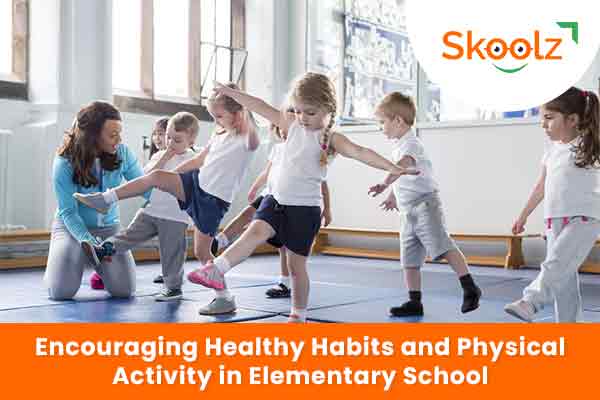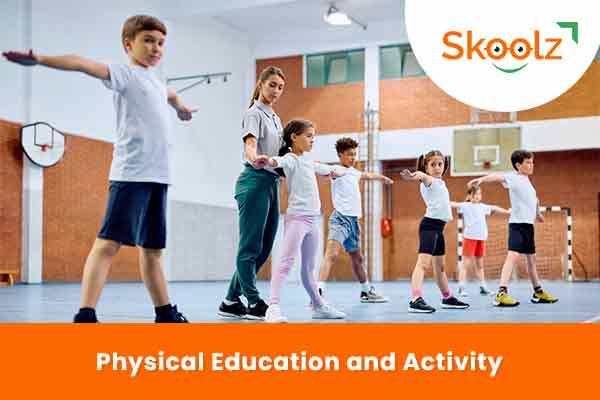
Encouraging Healthy Habits and Physical Activity in Elementary School
Encouraging Healthy Habits and Physical Activity in Elementary School
Promoting healthy habits and physical activity in elementary school is essential for the well-being and development of young students. At Skoolz.in, we recognize the importance of instilling these habits early in a child's education. In this blog, we will explore strategies and approaches that parents and educators can employ to encourage healthy lifestyles and physical activity among elementary school students.
Creating a Healthy Environment

Healthy Food Choices: Offer nutritious meals and snacks in school cafeterias and at home, encouraging students to make balanced dietary choices.
Hydration: Promote regular water breaks and provide access to clean drinking water throughout the school day.
Nutrition Education: Integrate nutrition education into the curriculum, teaching students about the importance of balanced diets.
Physical Education and Activity

Structured PE Classes: Provide regular physical education classes that focus on skill development, fitness, and fun physical activities.
Recess Time: Ensure that students have ample recess time for unstructured play and physical activity during the school day.
After-School Programs: Offer extracurricular sports and physical activities that allow students to explore their interests.
Outdoor Learning

Nature-Based Education: Implement outdoor learning experiences to connect students with nature and promote physical activity in natural settings.
Gardening Projects: Create school gardens where students can learn about nutrition, sustainability, and physical activity through gardening.
Community Involvement

Parent Engagement: Encourage parents to participate in school wellness committees and engage in discussions about healthy habits.
Local Partnerships: Collaborate with local organizations and businesses to promote community health initiatives, such as family fitness events.
Health Education

Health Curriculum: Develop a comprehensive health education curriculum that covers topics like physical health, mental well-being, and healthy habits.
Emotional Health: Include discussions on emotional well-being, stress management, and mindfulness in health education.
Role Modeling and Support

Teacher Role Models: Encourage teachers to serve as positive role models by embracing healthy habits and staying physically active.
Peer Support: Promote peer support and teamwork, creating an environment where students motivate each other to stay active.
Screen Time Management

Screen Time Limits: Set guidelines for screen time at school and promote limited screen time for entertainment at home.
Educational Technology: Use technology for educational purposes, incorporating active learning and movement into lessons.
Celebration of Achievements

Recognition: Celebrate and recognize students' achievements in physical activities and healthy habits to boost motivation.
Family Involvement: Involve families in celebrating their children's accomplishments related to health and physical activity.
Conclusion
Encouraging healthy habits and physical activity in elementary school is a collective effort involving parents, educators, and the community. Skoolz.in is committed to assisting parents and educators in creating an environment that promotes the physical and emotional well-being of elementary school students. By offering nutritious food options, structured physical education, outdoor learning experiences, community involvement, and comprehensive health education, we can empower students to develop healthy habits that will benefit them throughout their lives.
Disclaimer:
The information provided in this blog is for general informational purposes only. While Skoolz.in recognizes the importance of encouraging healthy habits and physical activity in elementary school students and presents strategies for doing so, the content presented here is meant to be informative and does not constitute specific medical, dietary, or fitness advice. Health and physical activity recommendations may vary based on individual circumstances and health conditions. We recommend consulting with healthcare professionals, nutritionists, and physical education experts to tailor these principles to the specific needs and health status of elementary school students.
Frequently Asked Questions (FAQs):
Q1: How can schools ensure that the meals provided in cafeterias are nutritious and balanced for elementary school students?
A1: Schools can work with nutritionists and follow government guidelines to plan and serve meals that meet nutritional standards, including fruits, vegetables, lean proteins, and whole grains.
Q2: What are some effective ways to promote hydration and ensure that students have access to clean drinking water during the school day?
A2: Schools can encourage students to bring refillable water bottles, install water fountains or hydration stations, and schedule regular water breaks during the school day.
Q3: How can educators integrate outdoor learning experiences into the curriculum while ensuring student safety and supervision?
A3: Outdoor learning can be organized with proper supervision and safety measures in place. Teachers can work with local nature centers or educators experienced in outdoor education to plan and lead these activities.
Q4: What strategies can parents use to limit screen time at home and encourage physical activity?
A4: Parents can set screen time limits, provide alternatives like outdoor play or sports, engage in physical activities as a family, and model balanced screen time behavior.
Q5: How can schools involve the community in promoting healthy habits and physical activity for elementary school students?
A5: Schools can collaborate with local organizations, invite community members for health-related workshops, and host family fitness events or health fairs.
Q6: What are some tips for teachers to incorporate physical activity into lessons without sacrificing educational content?
A6: Teachers can use active learning strategies, implement movement breaks, and integrate physical activity into lessons, such as math games that involve physical movement.
Q7: What are some common challenges in promoting emotional well-being and stress management among elementary school students?
A7: Common challenges include recognizing signs of stress, providing age-appropriate coping strategies, and creating a supportive and inclusive school environment that encourages emotional well-being.
We hope that these FAQs provide additional clarity on encouraging healthy habits and physical activity in elementary school students and assist parents and educators in implementing effective strategies. If you have more questions or need further guidance, please feel free to reach out to Skoolz.in for additional support and information.

Swati Sahu
Digital Marketer

Encouraging Healthy Habits and Physical Activity in Elementary School
Promoting healthy habits and physical activity in elementary school is essential for the well-being and development of young students. At Skoolz.in, we recognize the importance of instilling these habits early in a child's education. In this blog, we will explore strategies and approaches that parents and educators can employ to encourage healthy lifestyles and physical activity among elementary school students.
Creating a Healthy Environment

Healthy Food Choices: Offer nutritious meals and snacks in school cafeterias and at home, encouraging students to make balanced dietary choices.
Hydration: Promote regular water breaks and provide access to clean drinking water throughout the school day.
Nutrition Education: Integrate nutrition education into the curriculum, teaching students about the importance of balanced diets.
Physical Education and Activity

Structured PE Classes: Provide regular physical education classes that focus on skill development, fitness, and fun physical activities.
Recess Time: Ensure that students have ample recess time for unstructured play and physical activity during the school day.
After-School Programs: Offer extracurricular sports and physical activities that allow students to explore their interests.
Outdoor Learning

Nature-Based Education: Implement outdoor learning experiences to connect students with nature and promote physical activity in natural settings.
Gardening Projects: Create school gardens where students can learn about nutrition, sustainability, and physical activity through gardening.
Community Involvement

Parent Engagement: Encourage parents to participate in school wellness committees and engage in discussions about healthy habits.
Local Partnerships: Collaborate with local organizations and businesses to promote community health initiatives, such as family fitness events.
Health Education

Health Curriculum: Develop a comprehensive health education curriculum that covers topics like physical health, mental well-being, and healthy habits.
Emotional Health: Include discussions on emotional well-being, stress management, and mindfulness in health education.
Role Modeling and Support

Teacher Role Models: Encourage teachers to serve as positive role models by embracing healthy habits and staying physically active.
Peer Support: Promote peer support and teamwork, creating an environment where students motivate each other to stay active.
Screen Time Management

Screen Time Limits: Set guidelines for screen time at school and promote limited screen time for entertainment at home.
Educational Technology: Use technology for educational purposes, incorporating active learning and movement into lessons.
Celebration of Achievements

Recognition: Celebrate and recognize students' achievements in physical activities and healthy habits to boost motivation.
Family Involvement: Involve families in celebrating their children's accomplishments related to health and physical activity.
Conclusion
Encouraging healthy habits and physical activity in elementary school is a collective effort involving parents, educators, and the community. Skoolz.in is committed to assisting parents and educators in creating an environment that promotes the physical and emotional well-being of elementary school students. By offering nutritious food options, structured physical education, outdoor learning experiences, community involvement, and comprehensive health education, we can empower students to develop healthy habits that will benefit them throughout their lives.
Disclaimer:
The information provided in this blog is for general informational purposes only. While Skoolz.in recognizes the importance of encouraging healthy habits and physical activity in elementary school students and presents strategies for doing so, the content presented here is meant to be informative and does not constitute specific medical, dietary, or fitness advice. Health and physical activity recommendations may vary based on individual circumstances and health conditions. We recommend consulting with healthcare professionals, nutritionists, and physical education experts to tailor these principles to the specific needs and health status of elementary school students.
Frequently Asked Questions (FAQs):
Q1: How can schools ensure that the meals provided in cafeterias are nutritious and balanced for elementary school students?
A1: Schools can work with nutritionists and follow government guidelines to plan and serve meals that meet nutritional standards, including fruits, vegetables, lean proteins, and whole grains.
Q2: What are some effective ways to promote hydration and ensure that students have access to clean drinking water during the school day?
A2: Schools can encourage students to bring refillable water bottles, install water fountains or hydration stations, and schedule regular water breaks during the school day.
Q3: How can educators integrate outdoor learning experiences into the curriculum while ensuring student safety and supervision?
A3: Outdoor learning can be organized with proper supervision and safety measures in place. Teachers can work with local nature centers or educators experienced in outdoor education to plan and lead these activities.
Q4: What strategies can parents use to limit screen time at home and encourage physical activity?
A4: Parents can set screen time limits, provide alternatives like outdoor play or sports, engage in physical activities as a family, and model balanced screen time behavior.
Q5: How can schools involve the community in promoting healthy habits and physical activity for elementary school students?
A5: Schools can collaborate with local organizations, invite community members for health-related workshops, and host family fitness events or health fairs.
Q6: What are some tips for teachers to incorporate physical activity into lessons without sacrificing educational content?
A6: Teachers can use active learning strategies, implement movement breaks, and integrate physical activity into lessons, such as math games that involve physical movement.
Q7: What are some common challenges in promoting emotional well-being and stress management among elementary school students?
A7: Common challenges include recognizing signs of stress, providing age-appropriate coping strategies, and creating a supportive and inclusive school environment that encourages emotional well-being.
We hope that these FAQs provide additional clarity on encouraging healthy habits and physical activity in elementary school students and assist parents and educators in implementing effective strategies. If you have more questions or need further guidance, please feel free to reach out to Skoolz.in for additional support and information.

Swati Sahu
Digital Marketer



